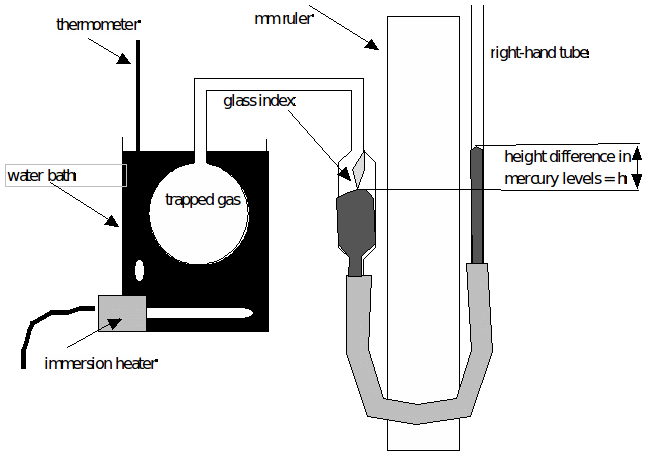The Constant Volume Gas Thermometer
Apparatus:
Gas thermometer apparatus, ice and thermometer.
Diagram (not to scale):

Procedure:
1. CHECK THAT THE IMMERSION HEATER IS NOT CONNECTED TO THE WATER BATH. CHECK THAT THE APPARATUS HAS HAD ITS STORAGE WIRES AND RUBBER BUNG REMOVED (ASK YOUR TEACHER TO CHECK THIS).
2. Surround the glass bulb with a mixture of ice and water, place the thermometer into the mixture and wait about five minutes until the glass bulb and the gas it contains reaches a temperature of about 0 C.
3. While you are waiting, measure atmospheric pressure,![]() in millimetres of mercury (mmHg), using the lab barometer. (ask your teacher if you need help to do this.)
in millimetres of mercury (mmHg), using the lab barometer. (ask your teacher if you need help to do this.)
4. Move the right-hand tube up or down until the mercury level in the left hand tube is just touching the bottom of the glass index (see diagram). Measure the mercury height difference, h in millimetres.
NOTE: If the mercury level in the right-hand tube is higher then h is a positive value, otherwise it is negative.
5. Record the water bath temperature T in 0 C.
6. The pressure,![]() of the trapped gas is equal to
of the trapped gas is equal to![]() plus (or minus)
plus (or minus)![]() in mmHg.
in mmHg.
7. REMOVE ALL THE ICE. ADD COLD WATER TO RESUBMERGE THE GLASS BULB.
8. Repeat stages 4 to 6 for the new water bath temperature.
9. Connect and switch on the immersion heater.
10. For a range of temperatures (MAXIMUM 80 C) repeat stages 4 to 6.
11. Tabulate all of your results
For small![]() where
where![]() is the acceleration due to gravity. Use your graph to calculate
is the acceleration due to gravity. Use your graph to calculate
g. Next using a long and constant value of length,![]() (e.g. around 100 cm), vary angle
(e.g. around 100 cm), vary angle![]() the angle of swing between 5 and 90 degrees, and measure
the angle of swing between 5 and 90 degrees, and measure![]() the time period of one swing.
the time period of one swing.
NOTE: In this case you will have to measure the period quickly using the first few oscillations otherwise the angle![]() will decrease significantly. Because of this you will have to repeat each angle measurement a number of times.] Over what range of swing angle is the period of swing more or less constant? Illustrate your answer with a graph.
will decrease significantly. Because of this you will have to repeat each angle measurement a number of times.] Over what range of swing angle is the period of swing more or less constant? Illustrate your answer with a graph.
Timing Swings:
At the end of a swing the bob is stationary for a brief instant before swinging back again. It is therefore difficult to identify the precise instant of the end of a swing since the bob is far out for a long time. At the centre of the swing the bob is moving rapidly, and the instant that it passes the central point is more precisely defined. Technically timing the swings from the central position is better. The period is NOT the time from the centre position to the next centre position. That is half an oscillation. The bob must be in the centre position AND approaching from the same side for a complete swing to be completed.It is common to use a fuducidal mark to assist in identifying the instant when the bob passes the centre position. To find the time of one swing you should time a number of swings so that the total time taken is at least 30 seconds and you should repeat this measurement at least twice more.